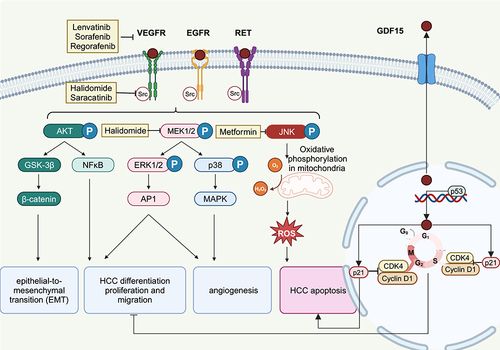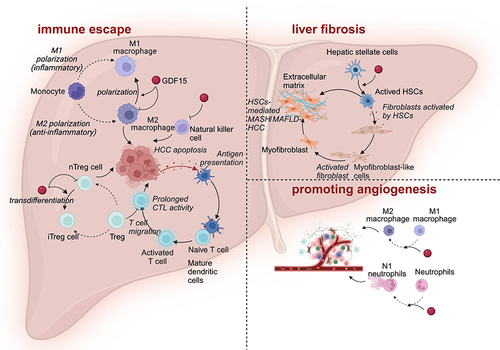Figures & data
Figure 1 Signaling pathway of the GDF15 expression. GDF15 induces proliferation and pro-angiogenic effects in HCC through the phosphorylation of Src and downstream AKT, MAPK, and NF-κB signaling pathways. GDF15 activates p53 pathway to inhibit HCC.P21 promotes HCC proliferation by facilitating the formation of the cell cycle protein D1-CDK4 complex. Created with BioRender.com.

Figure 2 Effect of GDF15 on immune cells in liver cancer immune microenvironment. GDF15 promotes HCC development in the tumor microenvironment through immune escape, hepatocyte fibrosis, and tumor angiogenesis pathways. GDF15 inhibits M2-type cell action and promotes M2 to M1 conversion, inhibits nTreg-type cell action and promotes nTreg to iTreg reprogramming, inhibits DC maturation and T-cell activation, and inhibits NK cells, which diminishes the pro-apoptotic effects of immune cells and promotes immune escape. GDF15 promotes hepatocyte fibrosis through activation of hepatic stellate cells and will promote the transformation of MASH/MAFLD to HCC. GDF15 promotes the transformation of M1 to M2 and the differentiation of neutrophils into the N1 phenotype, which promotes tumour angiogenesis and exacerbates HCC. Created with BioRender.com.

Table 1 Expression Level of GDF15 in Peripheral Blood of Patients with HCC
Table 2 The Main Agents and Its Mechanisms in HCC
